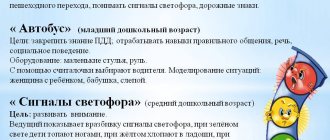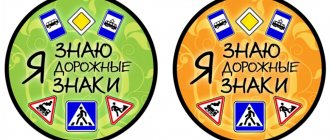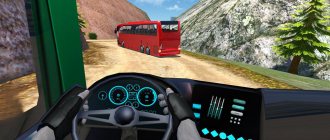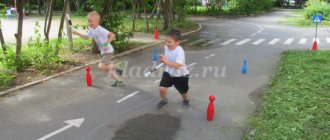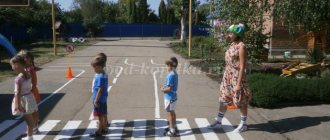Traffic light
The purpose of the didactic game “Traffic Light” is to develop an understanding of what a traffic light is, why it is needed on the road, and what the light signals mean.
The lesson is intended for the younger group of kindergarten. To carry it out, prepare a schematic representation of a traffic light with unpainted signal lights, and separately – cardboard circles of 3 corresponding colors.
Give the children circles and tell them what function the device performs on the road. Name the color one by one, and the children must guess and explain what the indicated color could mean: red - wait, yellow - wait, green - you can go. At the end of the lesson, students, with the help of the teacher, distribute circles according to signal lights.
Didactic game “Our assistant traffic light”
Didactic game: “Our assistant is a traffic light”
The game is intended for children of primary preschool age (from 2 to 4 years old). At the initial stage, children play games with an adult, then independently.
Target:
To form in children ideas about basic traffic rules.
Educational objectives:
Introduce children to the traffic light and form an idea of its purpose and signals: red light - STOP (prohibits movement), green light - GO (allows movement), yellow light - WAIT.
Form an idea of spatial relationships (above, below, in the middle).
To consolidate children's ideas about color - determine the circle of the desired color (visual correlation: red, yellow, green).
Activate and enrich children's vocabulary using words: signal, road, pedestrian, traffic light, pedestrian crossing; above, below, in the middle or between.
Developmental tasks:
Develop fine motor skills by performing actions with objects.
To develop children's attention and speech through the ability to listen, understand content and repeat individual words and verbal text.
Develop the ability to correctly place circles on a traffic light layout.
Educational tasks:
To develop children's pedestrian behavior skills.
Evoke an emotional response from the game process.
Rules and options for the game.
Game "Getting to Know the Traffic Lights"
The game is attended by two to four children and an adult leader.
The adult invites the children to get acquainted with the traffic light.
A traffic light is a friend to everyone, it is the most important thing on the road.
A traffic light indicates when you can cross the road and when you can stay put. All pedestrians must obey him.
Let's look at a traffic light - it has three signals: red at the top, green at the bottom, and yellow between them or in the middle.
Then the adult offers to repeat everything again, together, pronouncing the main phrases.
Sedentary game “Pedestrian crossing”
The game is attended by two to four children and an adult leader.
The presenter invites the children to be pedestrians and try to cross the road at a pedestrian crossing.
-And the traffic light will help us with this, listen carefully and do:
“Before you cross the road, look at me. If I turn on the red light, it means it’s dangerous to move (stop - the children are standing still), if the light is green, walk on - the path is open (walk - the children imitate walking), but the yellow light is on - there is no more crossing, don’t rush, wait, very soon the traffic light will light up a new eye (wait - the children stand and pronounce the words together with the leader, clapping their hands).”
The teacher accompanies the verbal text by showing the necessary signals on a traffic light model.
The game is repeated several times.
Game “Help the traffic light find its lights”
The game is attended by two to four children and an adult leader.
The traffic light invites children to play with it:
“Something happened to me and I lost my lights, please help me!” (children are asked to fix the traffic light).
Children take turns “helping” the traffic light.
During the game, the adult asks the children questions:
-What color is this light?
— Where is it located: at the top, bottom or in the middle?
- What does this light mean?
If children are having difficulties, the adult enlists another child to help.
As a result, the traffic light thanks all the children for their help and offers to always be friends and never forget about him.
Game "The traffic light has lost its light"
3 children can play. There are traffic lights in front of the guys. The traffic light has two colors, and instead of the third there is a white circle. And nearby there are chips of red, yellow and green colors. The child’s task is to pick up the right chip and put it on the traffic light where it should be. The one who completed the task faster than the others wins.
The game can be somewhat complicated by turning over the chips. Children take turns taking a chip, opening it and saying whether it fits their traffic light or not. If it fits, they keep it and put it on their traffic light.
Didactic game: “Our assistant traffic light” PPTX / 808.42 Kb
Find the warning lights
This game also requires a schematic representation of a traffic light with separate colored circles. But the task is more complicated, intended for the middle group: preschoolers select the signal lights themselves, focusing on the teacher’s leading questions.
Tell the students that there is a problem on the road: cars cannot move because the traffic lights are out of order. Ask the children to help the drivers, return the signals to their place.
During the game, ask the players one by one:
- what color is the signal;
- where it is located - at the top, in the center, at the bottom;
- which means.
If the child finds it difficult to answer, ask the same question to the next player.
Pick up the signal light
The game is competitive, 3 preschoolers play. Prepare for the lesson images of traffic lights, in which two lights are colored, and instead of the third there is an empty circle. You also need cardboard circles in 3 colors.
Place the images in front of the players. Ask them to remember what color the unpainted signal circle should be. Children remember, choose a cut out circle, and apply it to an unpainted traffic light. The player who makes the most correct moves and completes the task faster than his comrades wins.
The game for the preparatory group can be complicated by turning the cut out circles upside down. Players take turns taking circles, turning them over, calling a color, and seeing if the color suits their traffic light. If yes, they put it on the corresponding signal light; if not, they put it aside and pass the move to a comrade.
Traffic light
To conduct the game “Traffic Light” in the older group, make preparations: divide the landscape sheets in half, on one half depict a traffic light with incorrectly located lights, on the other - a device with empty circles instead of signals. Separately cut out circles of 3 colors.
The players' task is to identify the incorrect placement of lights. On the neighboring device you need to display the light signals correctly, arranging the circles accordingly.
Build a traffic light
The didactic game “Assemble a traffic light” reinforces the idea of the purpose of a road device, develops attentiveness and thinking abilities. For the lesson, prepare images of traffic lights - one per player, and circles made of cardboard in 3 colors. Randomly cut each circle into 4 parts.
Tell the students that the traffic lights are broken and need to be fixed. Children fold circles according to colors and order of arrangement. At the end of the work, the students tell what each traffic light means.
Didactic games on traffic rules
Recently, the problem of preventing children's road traffic injuries has become very relevant. Simply cramming traffic rules with children is very boring and ineffective. And small children will have difficulty remembering boring safety rules. Another thing is the game!!! Thanks to the didactic game, children will easily remember and learn the rules of the road (traffic rules). Thanks to didactic games on traffic rules, children of senior preschool age not only learn simple rules of behavior on the road, but also know how to classify road signs, know what they mean, and how to behave if they see this sign. I would like to offer some didactic games on traffic rules that you can make with your own hands, and which children really love.
Game "Cars"
The game is suitable for children of early and early preschool age.
Purpose of the game : to form children’s ideas about traffic light signals, to consolidate the sequence of traffic light colors. Develop fine motor skills of the hands.
Game composition : The game consists of a board with a picture of a road, cars on it and a traffic light.
Progress of the game : Car wheels and traffic lights are made of colored caps. The traffic lights are unscrewed, and the child screws them in the correct sequence. You can complicate the task and arrange the traffic lights in the wrong sequence. The child’s task is to correct the mistake.
Game “Assemble a traffic light”
The game is suitable for children of primary preschool age.
Purpose of the game : to consolidate children's ideas about traffic lights and their sequence.
Game contents : three traffic light templates with pockets for its signals, circles of three colors red, yellow and green.
Progress of the game : traffic light templates are laid out in front of the children, and a game situation is proposed that an evil wizard has enchanted the traffic lights and now they need to be repaired - to correctly designate the colors.
For children of primary preschool age, the process of the game itself is put in first place, and the result is secondary. Therefore, the tasks in such games are aimed more at the process of the game, and the result fades into the background.
Game "Cube with rules"
The game is suitable for children of middle preschool age.
Purpose of the game : to consolidate children's ideas about traffic rules for pedestrians and passengers.
Contents of the game : a cube made of cardboard, each face of which is covered with illustrations depicting road situations.
Progress of the game : the child throws the cube, describes the situation that appears on the top edge of the cube and tells what a pedestrian or passenger should do in this situation. For each correct answer, the child receives a smiley face. This game is suitable for individual work, but you can also play with a subgroup of children from 2 to 5.
Game "Pick up a sign"
The game is suitable for children of middle and older preschool age.
Purpose of the game : to consolidate children’s knowledge of road signs, the ability to navigate them correctly, classify them by type: prohibitory, prescriptive, warning, informational.
Contents of the game : cards illustrating road situations, containing a window instead of a sign and cards with road signs.
Progress of the game : children choose a card for themselves, consider the situations. The leader has road signs. The leader takes turns showing a sign, the player who has the required card takes this sign and justifies his choice.
Game "Collect a road sign"
The game is suitable for children in the pre-school group (6 – 7 years old).
Purpose of the game : to consolidate children’s knowledge of road signs, the ability to navigate them correctly, classify them by type: prohibitory, prescriptive, warning, informational. Develop visual memory.
Contents of the game : cards with images of different types of road signs: prohibiting, prescriptive, warning, informational; blank sign templates (white and red circles, blue rectangles, white and red triangles); component parts of signs (bus silhouette, white rectangle, silhouettes of men, red cross, etc.).
Progress of the game : While getting acquainted with the game, it is necessary to examine the signs in detail, classify them into subgroups and determine what they mean. After this, the children choose their own road sign and assemble them from their component parts. In the future, the task can be complicated by removing ready-made road signs. Children assemble a road sign from memory, tell what it means and compare it with the sample.
Game "Happy Journey"
The game is suitable for children of older preschool age (5 - 7 years old).
Purpose of the game : Reinforce the rules of the road, the designation of prohibitory road signs, the meaning of traffic lights.
Game contents : a playing field that you can make yourself, 2 – 4 game pieces in the form of cars, 1 cube with dots indicating the number of moves, 1 cube indicating a traffic light.
Game progress : all players place their chips on the circle with the inscription “START” and determine the order of moves. Then, one by one, they roll the dice and move the chip forward as many circles as the dice showed. If a player’s piece hits a prohibiting road sign, then the child moves it as many circles back as the arrow points to. If the player's chip lands on the circle with the image of a traffic light, then the player rolls the dice indicating the traffic light. If the color is green, the player moves again, if it is yellow, he moves the chip forward 1 move, if it is red, he skips the next move. The first one to reach the finish line wins.
Taxi drivers
This is an active game that reinforces ideas about the rules of the road, improves motor activity, and develops the skill of collective action and interaction with friends. For the lesson you need hoops and cardboard circles in 3 colors. Roads and pedestrian crossings must be marked on the playground.
The children are divided into pairs: one is a taxi driver, the other is a passenger. Each pair stands in a hoop, one child holds it with his right hand, the second with his left: this will be a car. Other children become pedestrians and traffic lights, while others receive 3 signal circles.
The game begins: taxi drivers and passengers run along the paths, pedestrians walk along the crossings, the rest show signal lights. Players' actions must be consistent with traffic signals. If necessary, the teacher gives hints and corrects the students’ movements.
Didactic games on traffic rules in the senior group
Didactic games on traffic rules for older preschoolers according to the Federal State Educational Standard
Game “Assemble a sign”
Objectives: to consolidate children’s knowledge about road signs and traffic rules; develop logical thinking, attentiveness; foster a culture of safe behavior on the road and in public places. Material: envelopes contain puzzles - road signs, chips. Progress of the game. Children are divided into crews (teams), at the teacher’s signal, they open envelopes and put together their signs from the parts.
To complete the task - 5 minutes. For a correctly assembled sign - 1 point. Extra points can be earned if players correctly answer the name of the sign and what its meaning is. Game “Cross the Road”
Purpose : to consolidate children’s knowledge about traffic lights. Progress of the game. The teacher alternately raises three circles: red, yellow, green. Children must cross the intended “road” (carpet path, passage marked with ribbons, pebbles, etc.). Children who cross the “road” into a red or yellow circle leave the game.
Game “Green Eye”
Purpose : to consolidate children’s knowledge about traffic lights. Progress of the game. A mock-up traffic light is installed at the entrance to the kindergarten.
When the children return after a walk, the teacher “turns on” the red light - “You can’t go”, then the yellow light - “Get ready.” You are only allowed to enter the premises when the light is green. Game “Our Street”
Purpose : to teach children to distinguish between road signs (warning, prohibiting, prescriptive, informational) intended for drivers and pedestrians. Material: model of a street with houses, intersection; cars (toys); pedestrian dolls; driver dolls; traffic light (toy); road signs, trees (layouts). Progress of the game. The game is played on a layout.
With the help of dolls, children, on the instructions of the teacher, act out various road situations. Game “Turns”
Goal : to develop coordination of hand movements (right, left), visual attention. Material: signs: “Move straight”, “Move right”, “Move left”; rudders. Progress of the game. If the teacher shows the sign “Move straight,” then the children take one step forward; if the sign is “Move right,” they turn to the right by moving the “steering wheel,” and if the sign “Move to the left,” they turn left by moving the “steering wheel.”
The one who makes a mistake leaves the line. Game “Crossroads”
Purpose: to consolidate children’s knowledge about traffic lights. Progress of the game. Four presenters, two of whom receive red circles, the other two - green, stand at the “crossroads”.
Children pretend to be pedestrians and cars. When the whistle blows, the presenters raise their respective mugs, and the “pedestrians” and “cars” begin to move. The next whistle indicates a change of traffic light signal, the drivers change places. "Pedestrians" and "cars" stop. After the next whistle, the movement resumes, and the offenders leave the game. Game “Guess the Transport”
Goals: to consolidate children’s ideas about transport, the ability to find objects by description; develop ingenuity, quick thinking and speech activity. Material: pictures (cards) depicting transport. Progress of the game. The teacher asks the children riddles about types of transport.
The child who guesses what kind of transport is being discussed in the riddle receives a picture with its image. Whoever has the most pictures at the end of the game is the winner. Game “Find a Safe Way”
Objectives: to reinforce the rules of the road and behavior on the road; develop thinking, memory, attention; Expand words knowledge. Material: model of a street (road part), road signs, traffic lights, transport (passenger cars, trucks), pedestrian dolls. Progress of the game. Children, on the instructions of the teacher, act out various situations on the model that promote safe movement along the streets.
Riddles about road signs
What a miracle this is. Two humps like a camel? This sign is triangular, what is it called? (Rough road.) This sign warns that the road here has a zigzag and a steep one awaits the car ahead... (dangerous turn). A striped horse, they call it “zebra”. But not the one at the zoo... People walk along it here. (Transition.) Where the steps lead down, Go down, don’t be lazy. The pedestrian must know: Here... (underground passage).
We recommend watching:
Quest is a traffic rules game for the older group. Abstract Scenario of a game program on traffic rules for children of senior preschool age Interactive game on traffic rules for children 5-7 years old Lapbook on traffic rules for children of senior preschool age
Similar articles:
Games on traffic rules for the senior group of preschool educational institutions
